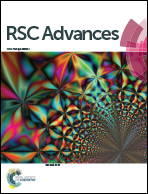Metal–organic frameworks in a blended polythiophene hybrid film with surface-mediated vertical phase separation for the fabrication of a humidity sensor†
Abstract
A facile, reliable, fast-response poly(3-hexylthiophene-2,5-diyl) (P3HT)-based humidity sensor was developed by introducing metal–organic frameworks (MOFs), HKUST-1, into the semiconducting layer. HKUST-1 displayed an excellent ability to capture water molecules, thereby generating and attracting charge carriers derived from the water molecules present in the active layer. The HKUST-1/P3HT hybrid film showed excellent device sensitivity with an enhanced electrical current and a threshold voltage shift as a function of the relative humidity due to the superior gas capture properties and the porosity of HKUST-1. The surface energy of the substrate altered the distribution and location of HKUST-1 in the active layer, which improved the sensitivity of the hydrophilic surface. A dynamic gas sensing test revealed that the hybrid film displayed a reliable and stable performance with fast response and recovery times. The introduction of MOFs into a conjugated polymer stabilized and sensitized the devices, providing a facile method of improving gas sensor technologies based on organic semiconductors.



 Please wait while we load your content...
Please wait while we load your content...